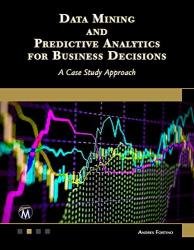 Название: Data Mining and Predictive Analytics for Business Decisions: A Case Study Approach
Название: Data Mining and Predictive Analytics for Business Decisions: A Case Study ApproachАвтор: Andres Fortino
Издательство: Mercury Learning and Information
Год: 2023
Страниц: 291
Язык: английский
Формат: pdf (true)
Размер: 39.5 MB
With many recent advances in data science, we have many more tools and techniques available for data analysts to extract information from data sets. This book aims to assist data analysts to move up from simple tools such as Excel for descriptive analytics to answer more sophisticated questions using machine learning. Most of the exercises use R and Python, but rather than focus on coding algorithms, the book employs interactive interfaces to these tools to perform the analysis. Using the CRISP-DM data mining standard, the early chapters cover conducting the preparatory steps in data mining: translating business information needs into framed analytical questions and data preparation. The Jamovi and the JASP interfaces are used with R and the Orange3 data mining interface with Python. Where appropriate, Voyant and other open-source programs are used for text analytics. The techniques covered in this book range from basic descriptive statistics, such as summarization and tabulation, to more sophisticated predictive techniques, such as linear and logistic regression, clustering, classification, and text analytics. Includes companion files with case study files, solution spreadsheets, data sets and charts, etc. from the book.
Features:
- Covers basic descriptive statistics, such as summarization and tabulation, to more sophisticated predictive techniques, such as linear and logistic regression, clustering, classification, and text analytics
- Uses R, Python, Jamovi and JASP interfaces, and the Orange3 data mining interface
- Includes companion files with the case study files from the book, solution spreadsheets, data sets, etc. (available with Amazon proof of purchase by writing to info@merclearning.com).
Table of Contents
1: Data Mining and Business. 2: The Data Mining Process. 3: Framing Analytical Questions. 4: Data Preparation.
5: Descriptive Analysis. 6: Modeling. 7: Predictive Analytics with Regression Models. 8: Classification.9: Clustering. 10: Time Series Forecasting. 11: Feature Selection. 12: Anomaly Detection. 13: Text Data Mining. 14: Working with Large Data Sets. 15: Visual Programming. Index.
Скачать Data Mining and Predictive Analytics: A Case Study Approach